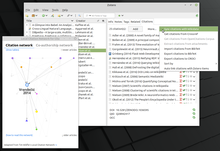Wikidata:Ferramentas/Visualização de dados
| Visualização de dados |

ChlamBase is an easily editable model organism database for Chlamydia that is built upon the WikiGenomes application framework, and Wikidata We allow you to lookup, add, and modify data in real time. Your data will instantly be visible, structured, and shared with the Chlamydial research community!







Navigable Family Tree (D3 inspired) of any human-like item in Wikidata. Also, you can use any property as a relationship to build taxonomies, org charts and so on.
Chrome browser extension that allows you to discover links and information about a topic you are browsing on other sites. Data live from Wikidata.
On-wiki documentation and discussion page: Wikidata:Entity Explosion
Examples from video demonstration:
- Platypus (Q15343) on iNaturalist.
- Jimmy Barnes (Q1689312) on Spotify.

GeneaWiki is a simple graph viewer showing genealogy information in Wikidata. Starting from a single person, it will try and construct the family tree according to father, mother, and child statements. For an example, see the Bach family.


Histropedia uses data from Wikipedia and Wikidata to automatically generate interactive timelines with events linked to Wikipedia articles. Combine timelines and events to create your own custom timeline and start playing lego with history! From ABBA albums to Zulu Kings, and almost everything in between, the timeline directory lets you discover thousands of timelines on hundreds of topics all from the search box on Histropedia.







A more advanced search and display of Wikidata items. The Reasonator is an organizer that uses simple reasoning to help narrow down search terms, producing more accurate search results. For example, search Barack Obama will list President Obama as the first result.


Science Stories is a linked data application powered by structured data. The facts about the lives of scientists from under-represented backgrounds stories are syndicated from Wikidata.
Lets you browse and query Wikidata. A special focus of SQID is to support the search of Wikidata properties and class items based on their usage. For example, you can find the properties that are used most often, or not at all, or only in qualifiers, etc. You can also get a list of all properties used by instances of the class Q5 (human), or, conversely, find all classes used on items that have an occupation (P106). Entity pages then show a lot of further data and live query results for every class or property, e.g., you can see all items used as values for P21 (sex or gender). Further usage examples are provided at the tool's start page.




Tool to visualize Wikidata items in a graph form using d3.js.

Tool to show and add relative position within image (P2677) qualifiers on depicts (P180) statements on Wikidata items as areas on the item’s image (P18).
Examples:

Tool to browse all chemical elements available on Wikidata, with atomic number, chemical symbol, and localized label. Now also includes two charts of the nuclides, with links to every isotope in Wikidata, colored by half-life or decay mode. Code available via Git (GPLv3 or later).

Shows tempo-spatial information from Wikidata, including a timeline of events and a map.

Web app that lets you visualize a list of items (specified by a Wikidata Query) in the form of a timeline.
Examples:
Tree structure of Wikidata entities. Used mainly for family trees and parent/sub organization structure.





